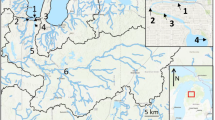Abstract
Semipermeable membrane devices (SPMDs) were deployed in the Columbia Slough, near Portland, Oregon, on three separate occasions to measure the spatial and seasonal distribution of dissolved polycyclic aromatic hydrocarbons (PAHs) and organochlorine compounds (OCs) in the slough. Concentrations of PAHs and OCs in SPMDs showed spatial and seasonal differences among sites and indicated that unusually high flows in the spring of 2006 diluted the concentrations of many of the target contaminants. However, the same PAHs − pyrene, fluoranthene, and the alkylated homologues of phenanthrene, anthracene, and fluorene – and OCs – polychlorinated biphenyls, pentachloroanisole, chlorpyrifos, dieldrin, and the metabolites of dichlorodiphenyltrichloroethane (DDT) – predominated throughout the system during all three deployment periods. The data suggest that storm washoff may be a predominant source of PAHs in the slough but that OCs are ubiquitous, entering the slough by a variety of pathways. Comparison of SPMDs deployed on the stream bed with SPMDs deployed in the overlying water column suggests that even for the very hydrophobic compounds investigated, bed sediments may not be a predominant source in this system. Perdeuterated phenanthrene (phenanthrene-d 10). spiked at a rate of 2 μg per SPMD, was shown to be a reliable performance reference compound (PRC) under the conditions of these deployments. Post-deployment concentrations of the PRC revealed differences in sampling conditions among sites and between seasons, but indicate that for SPMDs deployed throughout the main slough channel, differences in sampling rates were small enough to make site-to-site comparisons of SPMD concentrations straightforward.
Similar content being viewed by others
References
Bryant, W. L., Goodbred, S. L., Leiker, T. L., Inouye, L., & Johnson, B. T. (2007). Use of chemical analysis and assays of semipermeable membrane devices extracts to assess the response of bioavailable organic pollutants in streams to urbanization in six metropolitan areas of the United States. US Geological Survey Scientific Investigations Report 2007-5113. Portland, OR: US Geological Survey 47 p.+appendices.
Denoux, G., Gardinali, P., & Wade, T. L. (1998). Quantitative determination of polynuclear aromatic hydrocarbons by gas chromatography/mass spectrometry – selected ion monitoring (SIM) mode (pp. 129–139). In Sampling and Analytical Methods of the National Status and Trends Program, Mussel Watch Project: 1993–1996 Update. NOAA Technical Memorandum NOS ORCA 130.
Huckins, J. N., Petty, J. D., & Booij, K. (2006). Monitors of organic chemicals in the environment: Semipermeable membrane devices p. 223. New York: Springer.
Huckins, J. N., Petty, J. D., Prest, H. F., Clark, R. C., Alvarez, D. A., & Orazio, C. E., et al. (2000). A guide for the use of semipermeable membrane devices (SPMDs) as samplers of waterborne hydrophobic organic contaminants. Publication no. 4690. Columbia, MO: American Petroleum Institute.
McCarthy, K. A. (2006). Assessment of the Usefulness of Semipermeable Membrane Devices for Long-Term Watershed Monitoring in an Urban Slough System. Environmental Monitoring and Assessment, 118(1–3), 293–318.
Oregon Department of Environmental Quality (1999). Columbia Slough total maximum daily loads (TMDLs) for: chlorophyll a, dissolved oxygen, pH, phosphorus, bacteria, DDE/DDT, PCBs, Pb, Dieldrin and 2.3.7.8 TCDD p. 181. Oregon Department of Environmental Quality, Northwest Region: Oregon January.
Sericano, J. L., Gardinali, P., & Wade, T. L. (1998). Quantitative determination of chlorinated hydrocarbons (pp. 160–167). In Sampling and Analytical Methods of the National Status and Trends Program, Mussel Watch Project: 1993–1996 Update.NOAA Technical Memorandum NOS ORCA 130.
Author information
Authors and Affiliations
Corresponding author
Rights and permissions
About this article
Cite this article
McCarthy, K. Investigation of hydrophobic contaminants in an urban slough system using passive sampling – insights from sampling rate calculations. Environ Monit Assess 145, 31–47 (2008). https://doi.org/10.1007/s10661-007-0014-7
Received:
Accepted:
Published:
Issue Date:
DOI: https://doi.org/10.1007/s10661-007-0014-7




